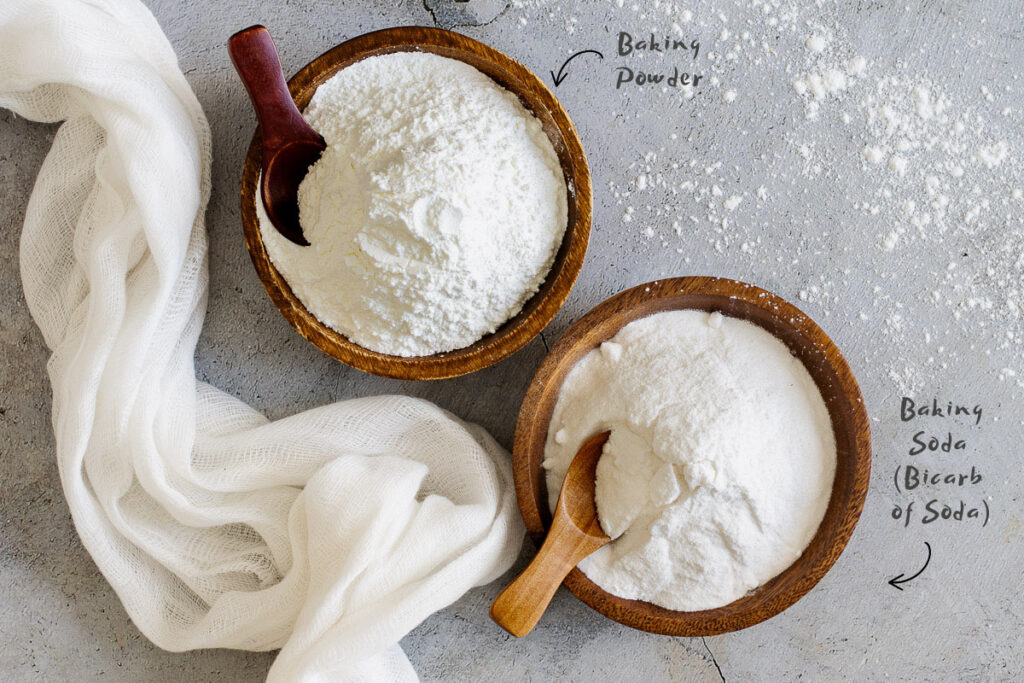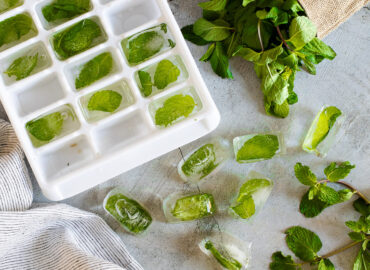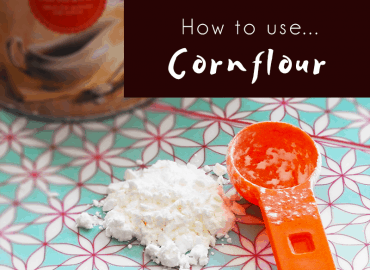*This post may contain affiliate links. Read my disclaimer here. While we may use affiliate links, we would never allow this to influence product listings or recommendations.
While bicarbonate of soda and baking powder may look alike, they are actually two different things that are used in different scenarios and should never be used interchangeably. Read on to learn more about what they are, their different uses and how to use them both effectively.
What is bicarbonate of soda?
You might see bicarbonate of soda referred to as a few other things such as baking soda, bicarb, sodium bicarbonate or natron.
Bicarbonate of soda is an alkaline chemical compound that is often used as a leavening agent in food. Sounds too technical? Basically, it is a substance that is used in baking because it helps baked goods to rise (leaven) and become fluffy and delicate. It needs to be combined with an acid in order to activate and work. While you might be wondering what kind of acid you can safely use in cooking, many foods are slightly acidic, including fruits, soured dairy products and even chocolate.
Bicarbonate of soda is 4 times stronger than baking powder in terms of its leavening effects.
You might see bicarbonate of soda used for a plethora of other things, particularly uses that relate to deodorising and cleaning. It naturally kills bacteria that cause odour and other things, making it a perfect choice for other household uses.

What is baking powder?
Baking powder actually contains bicarbonate of soda, along with an acid and a starch (usually cornflour/cornstarch. This stops it from reacting before you come to use it. Since baking powder is mixed with other things it is less potent than bicarbonate of soda and you will need around 4x more baking powder than soda to have the same effect.
As baking powder contains the acid that is required to react and cause the food to rise you don’t need to add any extra acid.
Baking powders these days are double-acting. This means that they contain two types of acid. One which will dissolve quickly with moisture when first added to a dough or batter and cause a small reaction. The second reacts with heat, typically at 60C or 140F, and helps the goods rise even more.
So which is best to use?
Whether you should reach for bicarbonate of soda instead of baking powder really depends on the recipe and the ingredients. Both very much have their place. In recipes that call for bicarbonate of soda, there is usually enough acid present to allow the soda to react.
Bicarb is also better for recipes that are going to go straight into the oven, as it activates immediately on contact with the acid.
On the other hand, baking powder is suitable to use in recipes where you don’t have any acid since it contains the ingredients required to activate without any additions. It is also better for recipes that are not going to be baked immediately as it will also react when heated in the oven and not just as soon as it is added to the recipe.
Sometimes you may find recipes that call for both soda and powder. This is usually as the recipe contains just enough baking soda for the amount of acid in the recipe, but not enough to cause enough of a reaction or rise when baked.
How much do I need to use?
To raise one cup of flour or 120g, you will need 1/4 teaspoon of bicarbonate of soda or 1 teaspoon of baking powder.
If you use bicarbonate of soda then you will need a further 125ml or 1/2 cup of acid ingredient for the reaction to take place. With baking powder, you don’t need to add any other ingredients to activate it.

Can I substitute them for each other?
You cannot substitute baking powder for baking soda without making adjustments to the recipe. If you substitute baking powder for bicarbonate of soda you will need to quadruple the amount used. This will likely affect the taste of the finished product. Additionally, if it’s for a recipe that isn’t going straight into the oven then the reaction may happen before the goods are baked, giving a sunken or dense result.
If you substitute bicarbonate of soda for baking powder then you would need to add enough acid to activate the soda. Again, this is likely to affect the end result and taste of the recipe.
It’s better to buy the missing ingredient than to try and make adjustments as the result simply won’t be the same.
Do they go ‘off’?
Both baking powder and bicarbonate of soda need to be fresh to work well. Something to note is that depending on how it has been stored, the freshness, and therefore the effectiveness may weaken before the expiry date of the product. The good news is that you can actually test the potency of both before using them rather than being left with disappointingly dense baked goods. Here’s how:
| Bicarbonate of soda | Baking Powder |
| 1. Add a teaspoon of soda to a small bowl 2. Pour over a tablespoon of vinegar 3. If it vigorously bubbles up then it’s fresh. A few limp bubbles means it’s past optimal use. | 1. Half fill a small bowl or cup with hot water 2. Sprinkle in a teaspoon of baking powder 3. If it fizzies up then it’s good to go, if there is no reaction then it is past its best. |
Looking for some recipes to test your newfound knowledge? Try:

Coffee and Walnut Cupcakes 
Yorkshire Parkin 
Date and Walnut Cake 
Carrot Cake Traybake







